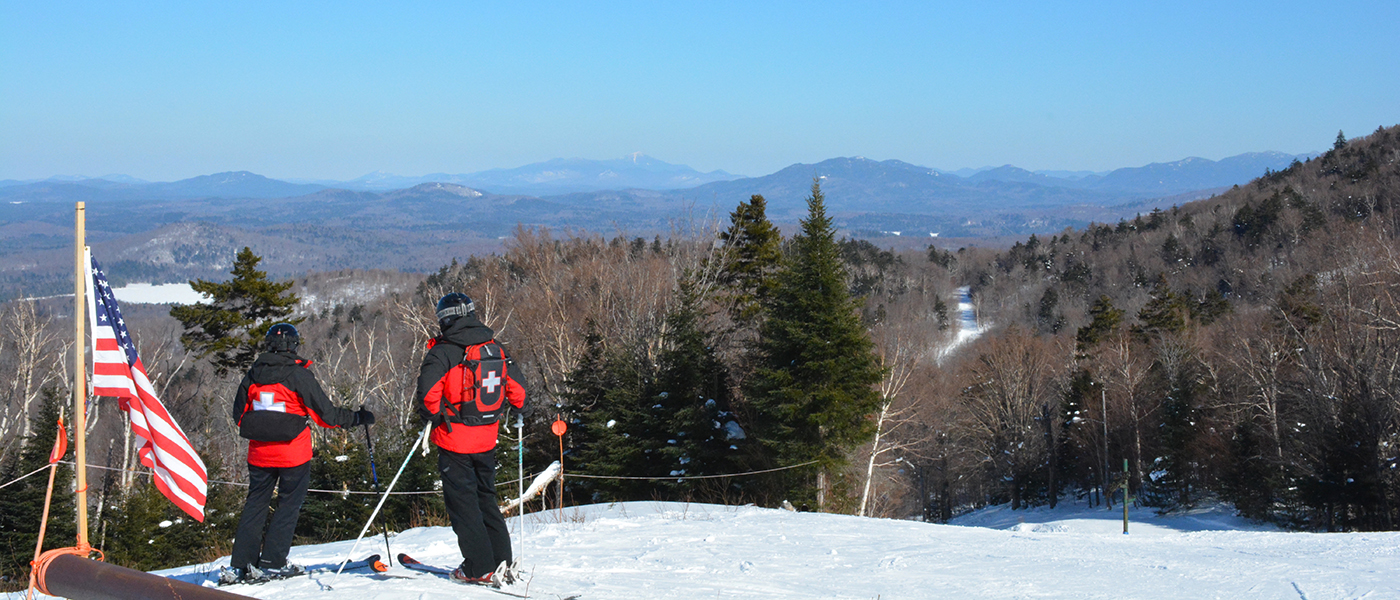
last ones off
Behind the scenes with the Big Tupper Ski Patrol
They’re the first ones on the mountain and the last ones off, and in between those opening and closing runs, Big Tupper’s ski patrollers sure have a full day.
I recently spent some time with the Big Tupper Ski Patrol to see what it’s like to fill their skis. On a sunny, bluebird, Saturday morning, I headed out to meet Ted Merrihew, Operations Co-Coordinator. It was around 8 a.m. and I found the crew at the patrol building booting up as they got ready to check out the mountain. Big Tupper opens up to the public at 9 a.m., so before then, the patrol needs to ski every trail on the mountain to ensure it’s safe. After each trail is skied, patrollers call in trail conditions over the radio, which are recorded in the patrol building and then distributed to the mountain’s office staff and the media for skiers and riders to access.
There are 18 members of the patrol, all volunteer, and on average about ten members are present Friday-Sunday. There are some folks who will make it to the mountain Friday-Saturday and others who pitch in when they can, but overall, it’s a hearty crew brought together solely on their desire to see Big Tupper up and running safely. 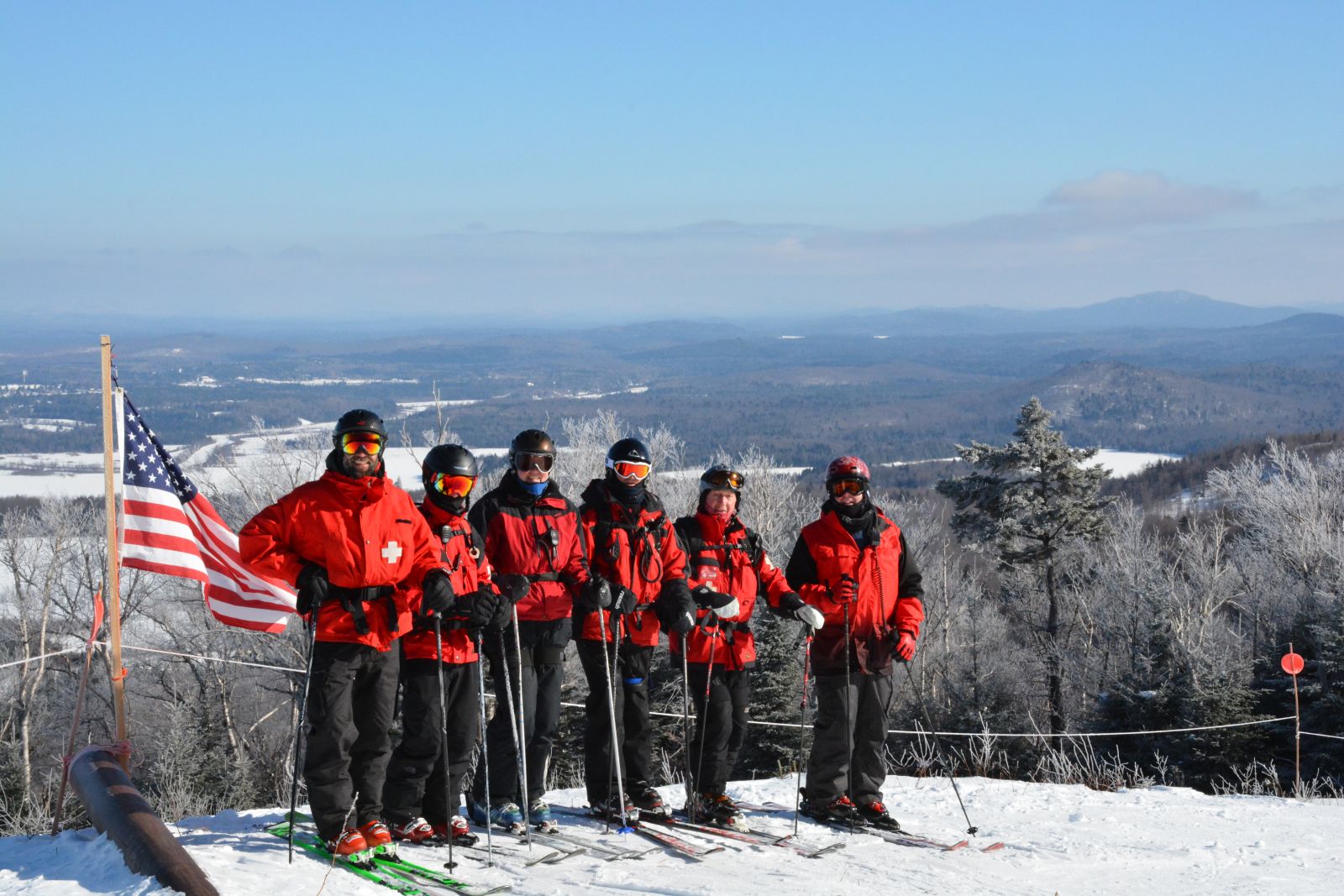
With two chairlifts and a beginner Mitey Mite, there are thirty trails to sweep, so the group always begins with Chair 2 and then moves on to opening up Chair 3. As I rode up the lift with Merrihew, patrollers’ voices, one-by-one, broke in over the radio with trail names and details such as “powder/packed powder” followed by the patroller’s name. We took runs down trails 5, 7, and Lift Line, with Merrihew radioing in the conditions each time we hit the bottom of the trail. I’ve skied in the early morning when there’s barely a soul around, but I’ve never been first on the hill, and this was pretty spectacular. Merrihew noted that one of the perks of being a patroller is having the chance to have the mountain all to yourself during those early runs of the day, and with sunny, blue skies and untouched trails before us, he was definitely right.
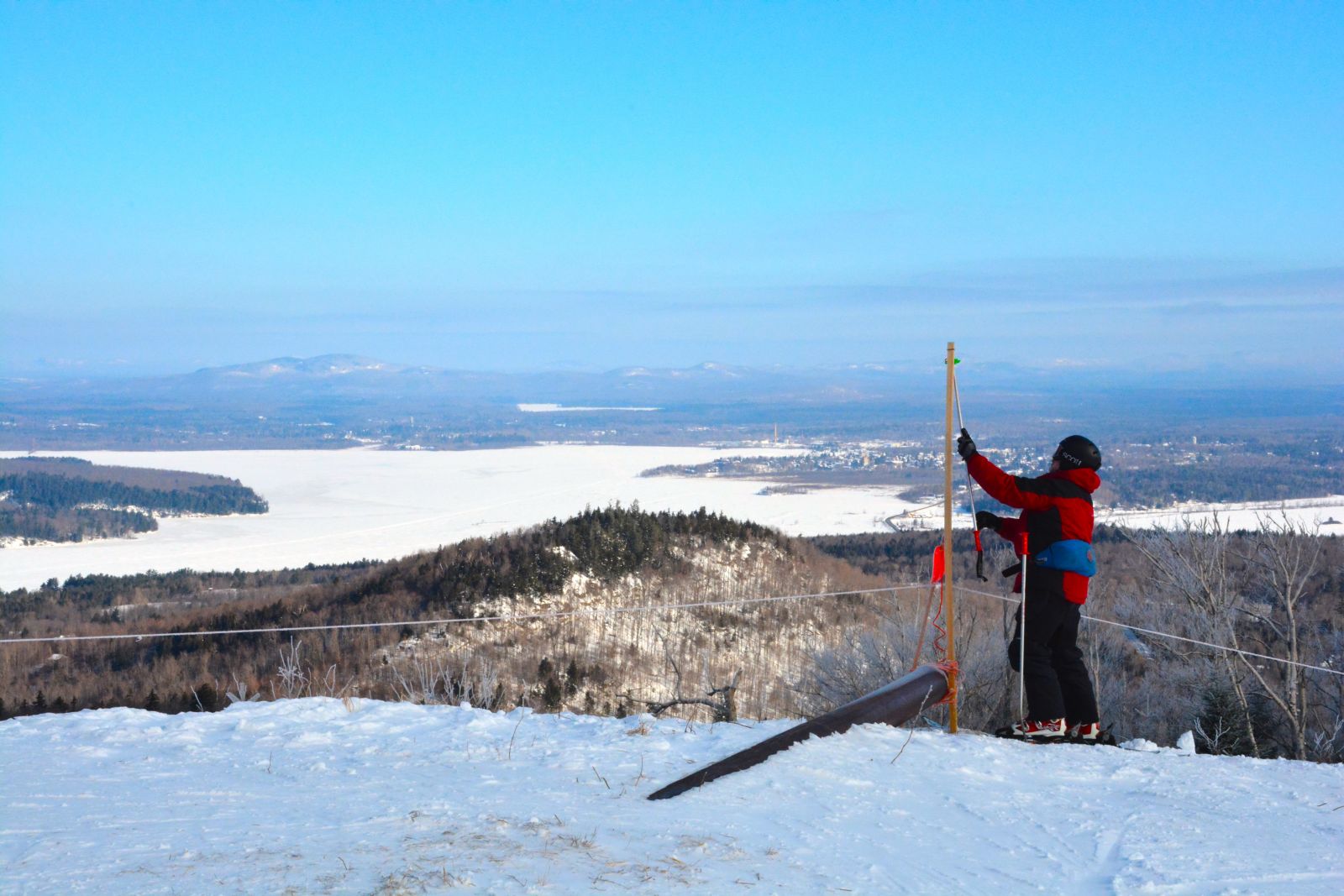
The rest of the morning was spent putting up “pops,” which are orange discs that alert skiers and riders to any rocks or other hazardous objects or spaces that they should avoid. We continued working our way up to Chair 3 to get that area of the mountain open as soon as possible. After soaking in the clear view of Big Tupper Lake that the top of Chair 3 throws in your face, we headed down Spruce Run and found our way back to Chair 2 via Trail 1.
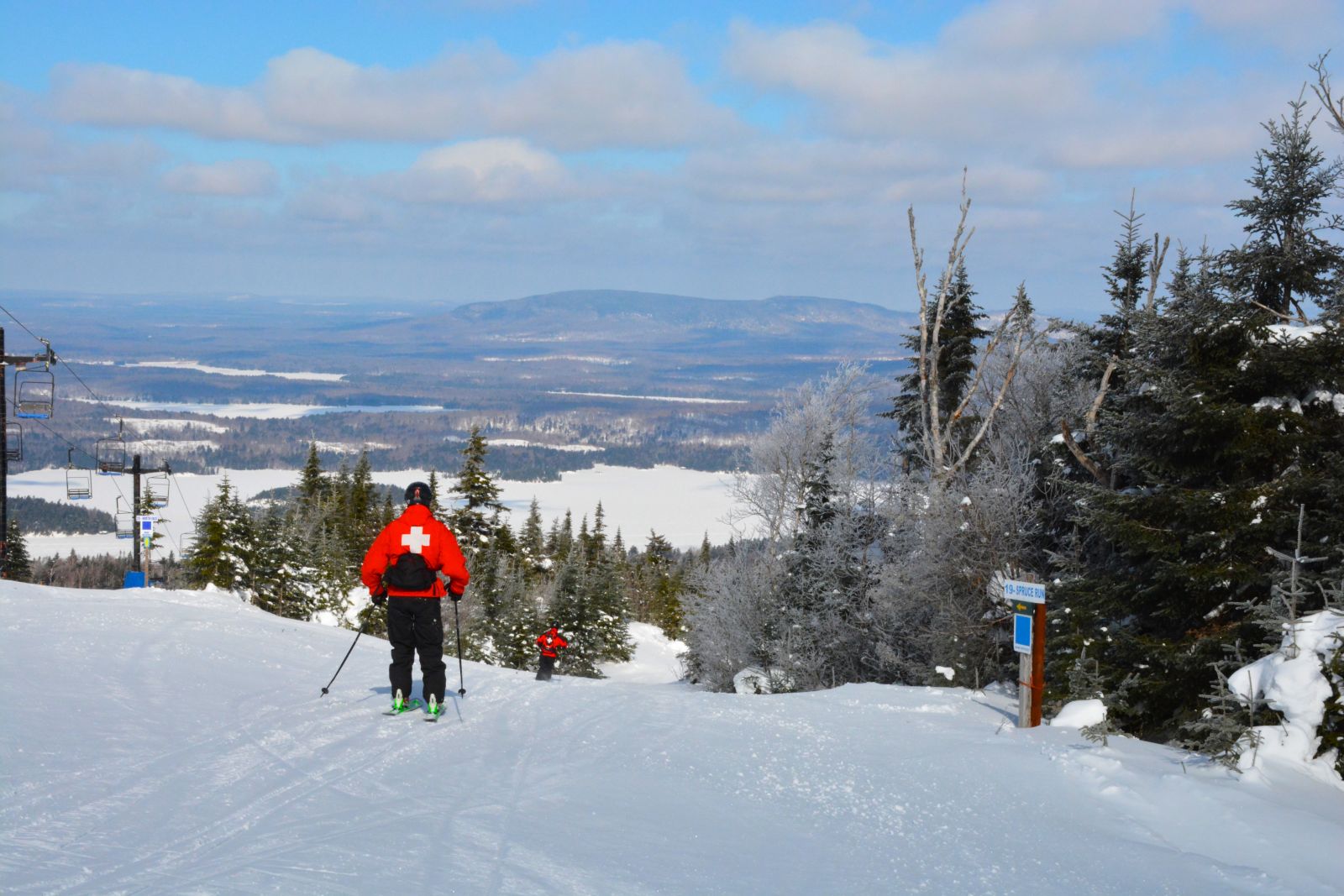
On our next lift ride, Merrihew told me about a few guys from Potsdam that he had run into the day before on the mountain. They had shared with him how excited they were to have Big Tupper open, giving them a close-to-home mountain to ski in addition to Titus and Whiteface. They also noted how great it was to ski on natural snow.
“The word is out that people want to ski on natural snow,” Merrihew added.
First-hand on the hill
After a mid-morning team meeting, I learned that my day was about to get a little more interesting. At the meeting, Tom Sciacca, Operations Co-Coordinator with Merrihew, divided the group into two teams and delivered the specifics of two training scenarios, explaining that I’d be the lucky victim in both of the events. I’ve fortunately never had to have ski patrol come to my aid or to ride in a sled to the base of the mountain, so I was definitely intrigued to see what it’d be like.
After the meeting adjourned, everyone made their way up Chair 2 and were then directed to meet at the bottom of Cliff’s Cliff. Merrihew and I got a head start so we could make it to the scene first. After finding my place and rehearsing my lines, the team was on the scene.
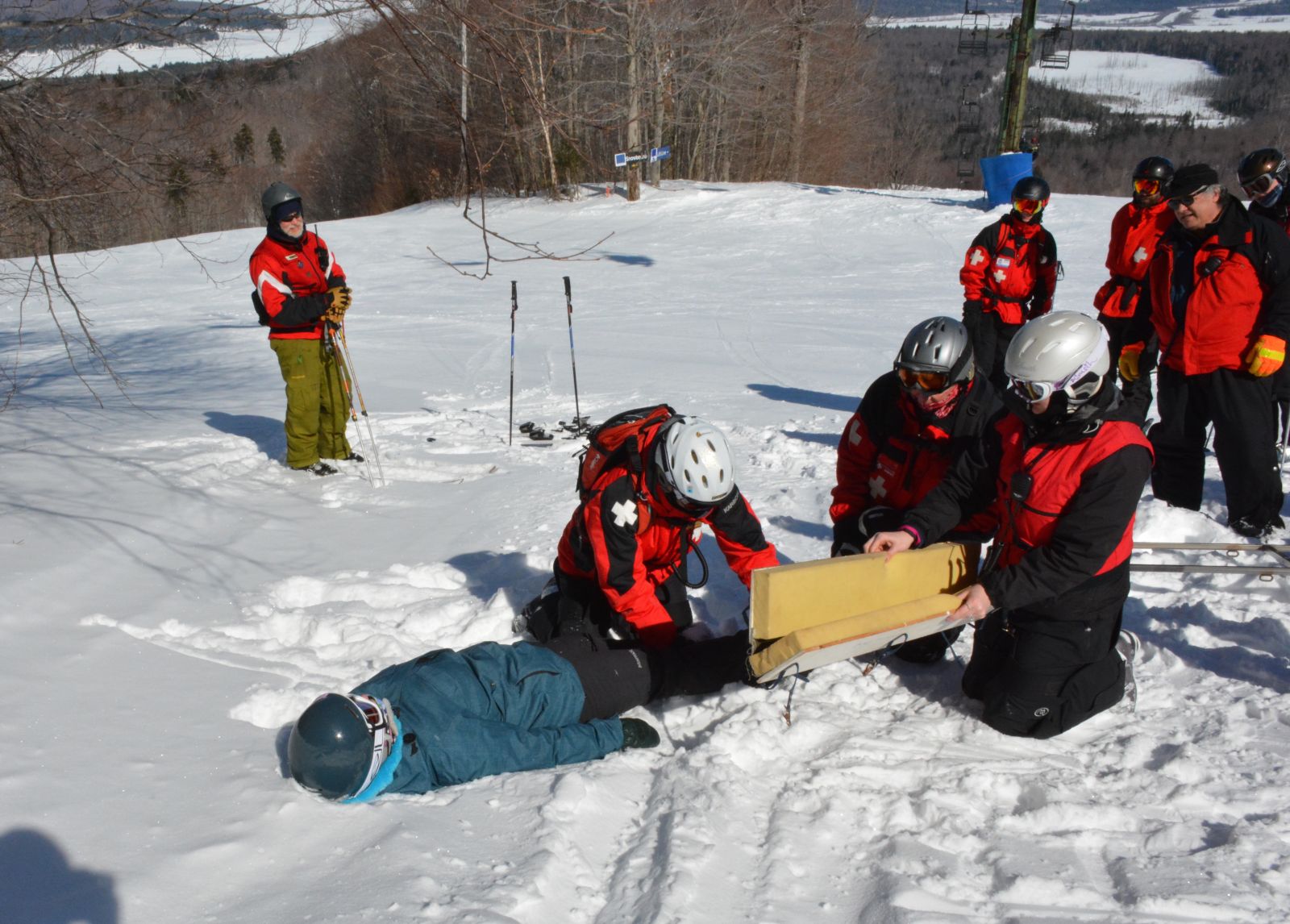
The team of patrollers came in and made sure the scene was safe. They put up skis and other barriers to ensure that no oncoming skiers would run into us, and then proceeded to ask me a thorough list of questions to diagnose my injury and make a plan of action. As instructed by Sciacca, I reported to the patrollers that my lower leg hurt a lot and I couldn’t feel my toes, and that my face hurt after falling on it. It was clear that the crew knew their stuff, as they listened to my complaints and followed-up with further questions, and then eventually got me into the sled to be transported down to the bottom of the hill. Since I wasn’t really injured I didn’t take the ride down the hill, instead, Sciacca said that I was going to drive my own sled down.
To be honest, at first I thought his dry sense of humor was coming out, but it became clear that there was no joking about it. He meant that I was going to drive like a ski patroller would down to the next site. With his boost of confidence that I could figure it out, I put my skis on and found my way in front of the sled, learning quickly how to operate the sled’s drag bar/brake. I felt a little like a new driver learning how to drive standard, with a herky, jerky, stop, bump, and boom repetition for the first bit of the ride, but once I got a hang of the rhythm of raising and dropping the bar to control my speed, it was fun cruising down Lift Line. I also had the help of Anne Maltais, a patroller who took on the job of tail roper, which helped to ensure it was a smooth ride down. By the end of my short drive, I was glad to have reached our destination; it was definitely a good upper body workout so I can only imagine what it would be like to handle one of those things on a steeper pitch with a hefty person in it, because you certainly don’t get to choose either of those conditions in a real life scenario.
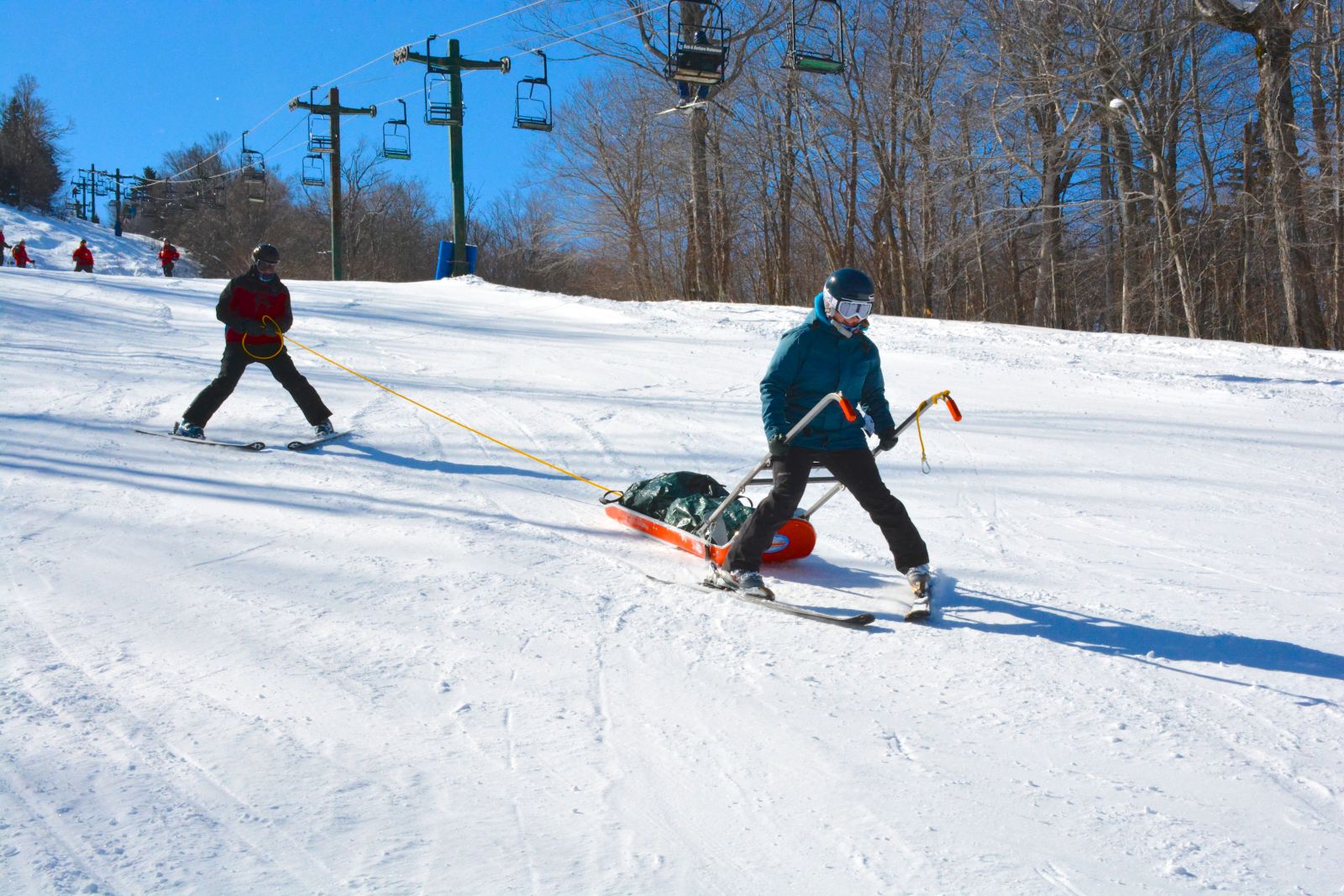
The second spot was a little way into the woods off of Lift Line, where once I was in place I reported that my injuries included severe low back and head pain. This situation was more serious than the previous one and therefore required more technical gear to ensure that I was transported to the base of the mountain with as little movement to my body as possible. Again, the team made their way through a series of in-depth questions, allowing them to diagnose the situation and create a plan of action. They worked together as a team and put a neck collar on me to ensure that my head and neck were stabilized. I was then positioned onto a backboard and put into the sled, and this time I was going to get to ride, not drive.
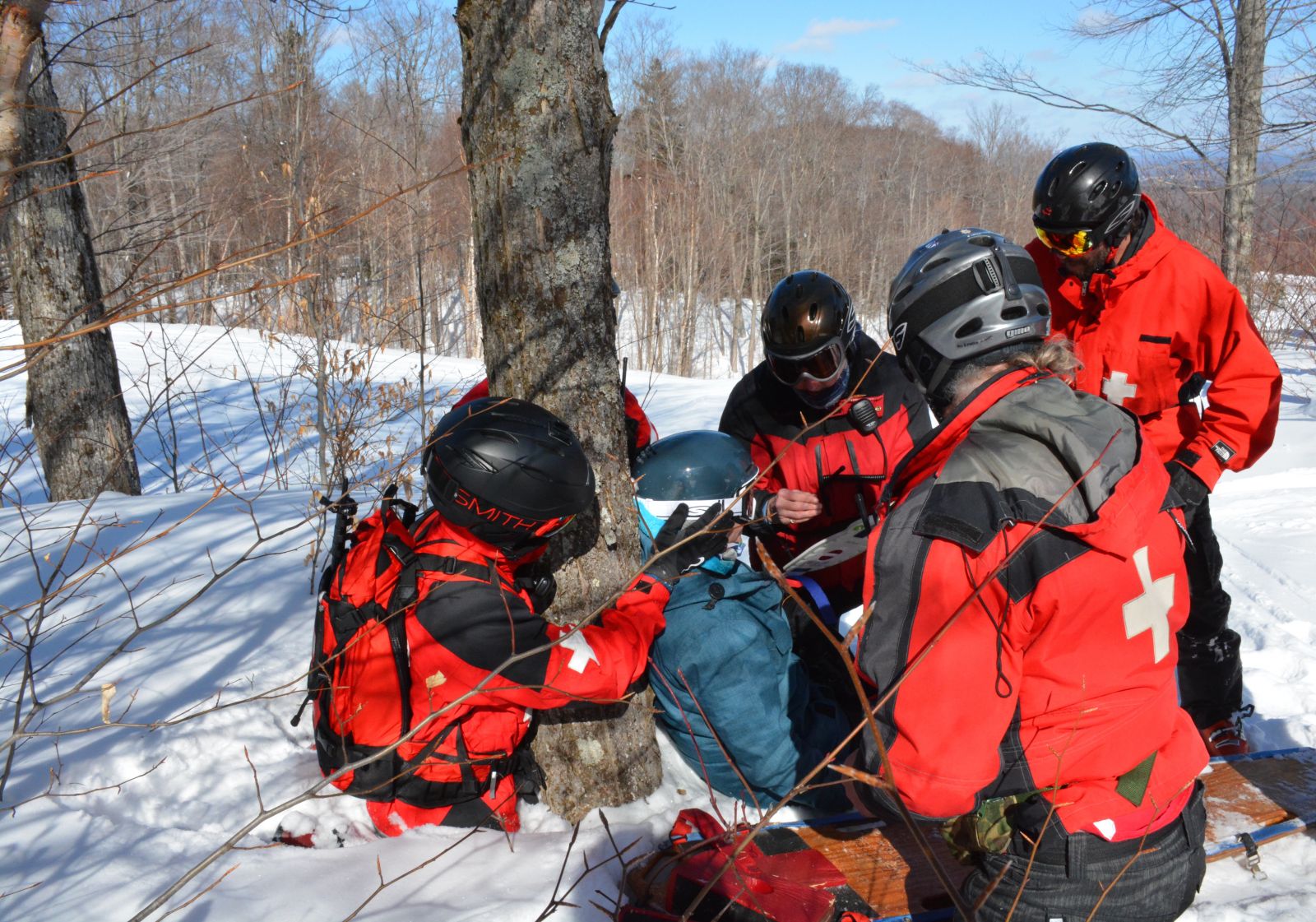 Once I was secure in the sled they wrapped me in a blanket and a tarp for warmth, and protection from the elements, and then strapped me in for safety. Patrolman Mitch Harriman drove the sled down to the patrol building, while Charlie Hoffer skied by the sled’s side with the tail rope. It was a neat experience to ride down a trail that I’ve skied down so many times before. I couldn’t see around me, only up, since I was so securely fastened into the sled, so to guess where we were or when the ride would end was interesting. I give Harriman and Hoffer a lot of credit, especially Harriman since he was the driver, they offered me a smooth ride down to the base of the hill. Of course, I hope no one has to ride in a sled, but if you do, trust me - you’re in good hands.
Once I was secure in the sled they wrapped me in a blanket and a tarp for warmth, and protection from the elements, and then strapped me in for safety. Patrolman Mitch Harriman drove the sled down to the patrol building, while Charlie Hoffer skied by the sled’s side with the tail rope. It was a neat experience to ride down a trail that I’ve skied down so many times before. I couldn’t see around me, only up, since I was so securely fastened into the sled, so to guess where we were or when the ride would end was interesting. I give Harriman and Hoffer a lot of credit, especially Harriman since he was the driver, they offered me a smooth ride down to the base of the hill. Of course, I hope no one has to ride in a sled, but if you do, trust me - you’re in good hands.
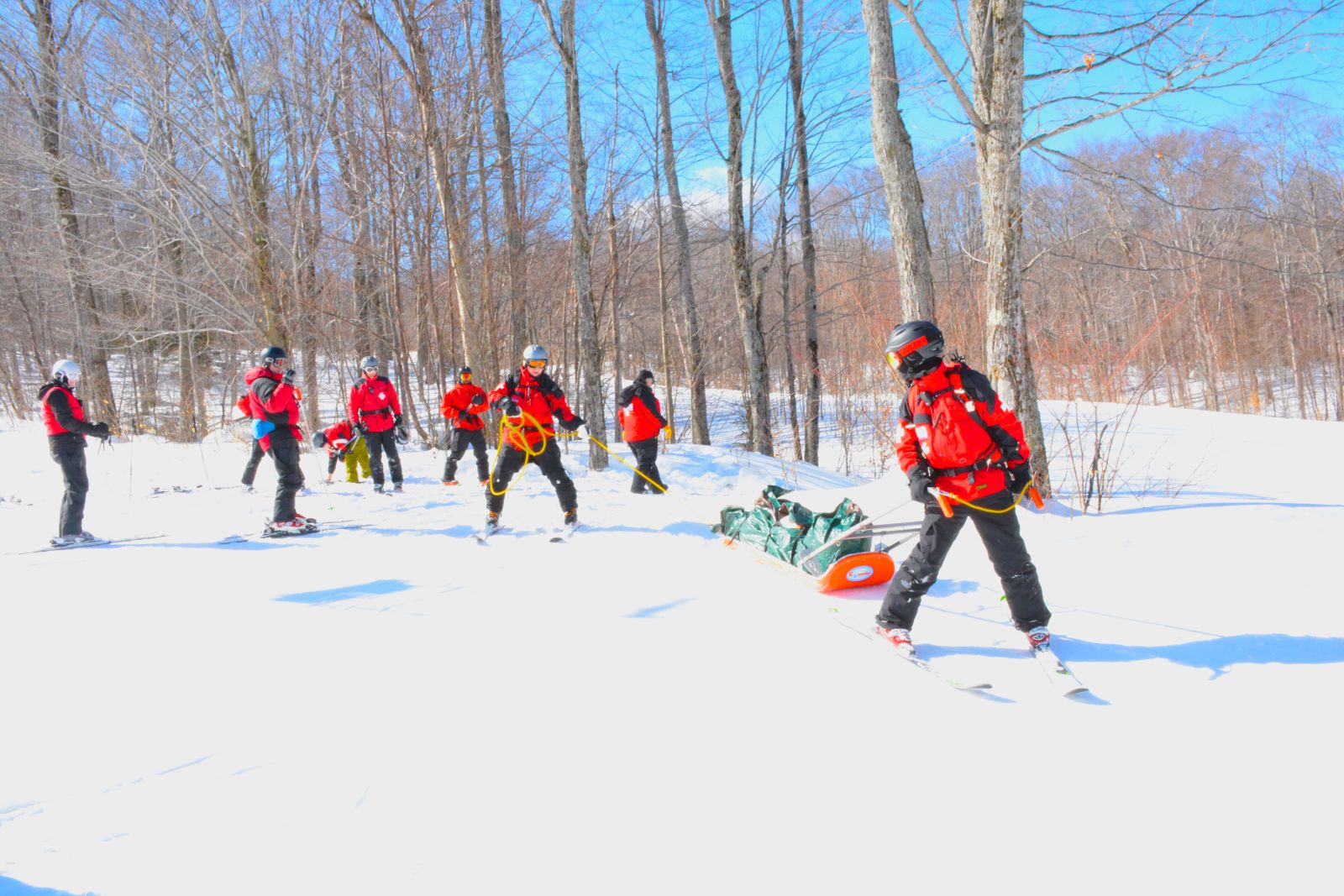
When we reached the building, Sciacca asked me my thoughts on the experience. I noted how clear it is that a lot goes into the training of patrollers so that they are prepared to deal with whatever they find on the scene. He agreed with me and noted the importance of frequent, on-the-hill training. This type of training is in addition to the specified trainings of: Outdoor Emergency Care, First Aid, CPR, AED, sled handling, lift evacuations, and a variety of other simulations and topics that each patroller must master before taking on the job. In sum, it’s a lot of work and a lot to know.
“To do stuff in the classroom and to do it on the hill are two different things,” Sciacca said, while noting that there is a thirty-step assessment procedure that patrollers must adhere to when dealing with an accident. He expressed the importance of patrollers being able to go through the mechanics of the steps with confidence; a confidence that’s gained through practice and experience.
A hearty crew, then and now
In addition to their professionalism and passion for ensuring the safety of skiers and riders on the mountain, one of the most notable traits of this crew was the jovial camaraderie that filled the patrol building when the group was gathered.
They operate out of a no-frills building that sat shuttered for more than ten years since the mountain’s closing in April of 1999, and they’ve somehow managed to turn this small space into a cozy common space. When you walk into the building that stands between the main lodge and Chair 2, you first notice a long card table that is filled with baked goods and treats that different patrollers have brought in to share. You might also catch a whiff from the couple of crockpots set up in the equipment room waiting for folks to enjoy during their lunch hour. You know whose fine work rests in the crockpots if you take a look at the whiteboard near the door which details a schedule of who’s up for the weekend as the group takes shifts bringing in lunch.
These are small details that symbolize a larger spirit that is commonplace for this patrol since its early days, and that’s their willingness to work hard, but to have a good time while doing so. The group ranges from high school students to retirees and brings together an immeasurable amount of years of experience and perspective. It’s a neat group to see in action, with some brand new to the job, others who also patrol at Whiteface Mountain and have done so since Big Tupper’s closing, and another crew who put away their patrol jackets when Big Tupper closed but are back at it again.
“That’s all it took – I was hooked”
A while back I had the chance to talk to Jim Kucipeck, who was a volunteer patrolmen at Big Tupper from 1962 to 1989. We talked a lot about the early days of Big Tupper and its ski patrol, and the impact the mountain had on the community. I’ve included some of his thoughts from that conversation, as they seem to give a quick glimpse into the rich history of Big Tupper’s beginnings and how it has carried forth into today.
“It’s easy to talk about Big Tupper because it had such an impact on the community,” Kucipeck said. “It was a family affair. It was a place for the kids to ski and it was an activity on the weekends and at night. I hope it comes back for all of our sake.”
In talking about his memories of Big Tupper, Kucipeck recalls how he spent afternoons during his childhood in the '50s. He says he’d carry the skis his mother bought him from Futterman’s Furniture Store on his shoulders as he walked up Demars Boulevard to a local hill known for skiing. He’d spend all day climbing up the hill and skiing into the pastures below.
Like many people in Tupper Lake, who spent their winter days climbing hills or being pulled by a ski tow on Manning’s Hill or Sugar Loaf Mountain, Kucipeck’s life changed in 1960 when the 1,152 foot vertical Big Tupper Ski Area was established on the 3,136' Mount Morris.
“When Big Tupper opened, my mother gave me enough money to ski for one day. That’s all it took – I was hooked,” said Kucipeck.
Kucipeck purchased his first season ticket for $25 and that year was exposed to a tradition that swept the national ski culture beginning in 1938 – ski patrolling.
“I saw the ski patrol and I knew I wanted to be a patroller,” he said. “I got on in 1962 as a junior patroller.”
I’m sure Kucipeck would agree that since those early days of patrolling, the mountain has gone through many changes, as has the ski patrol. But one thing has remained constant, and that’s what was noted by Merrihew as we enjoyed some crockpot delicacies in the patrol building during lunch, “This is a real good group of people to work with.”
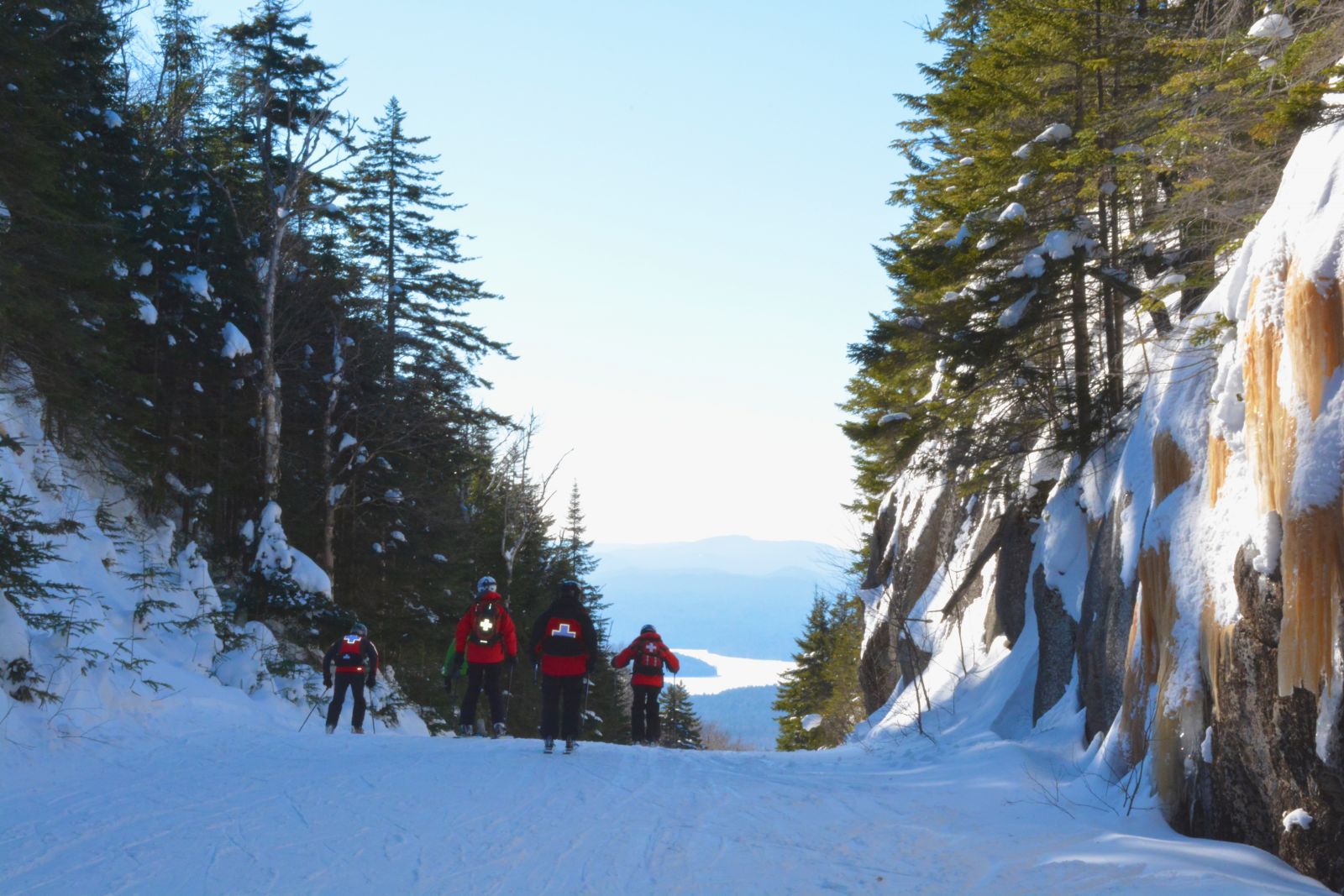
While ski season at Big Tupper has come to a close, there are still plenty of outdoor activities to keep you on your toes. Check out this recent blog which details 9 great tips to beat Cabin Fever!
